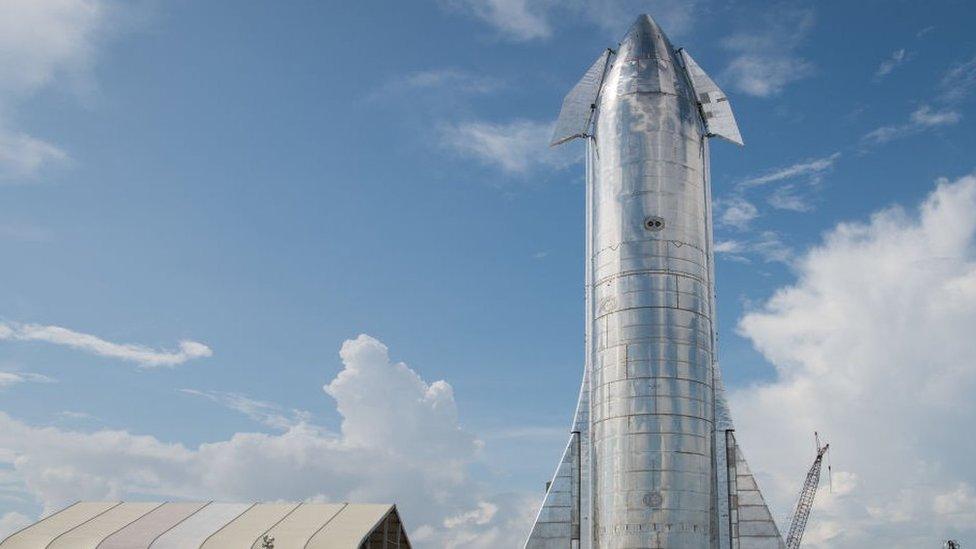What are the big events to look out for in Space in 2022?
- Published
- comments
Dr Maggie gives her top rocket launches to look out for in 2022
2021 was a HUGE year for space.
We saw a rover land on Mars, an intergalactic taco night and even worms on the International Space Station!
And it looks like 2022 is set to be jam-packed too!
Here's just some of what you can look forward to...
Intergalactic telescope

This mirror is one of the most important parts of the telescope
The James Webb Space Telescope (named after the man who ran Nasa when people first landed on the Moon) was launched into space over Christmas in 2021 and has now successfully opened its massive sun shield.
The shield, which is the size of a tennis court, was unveiled using motorised pulleys and cables.

Here you can see a scientist testing part of the telescope as it's being built
The telescope will use state-of-the-art infrared technology to learn more about the history of outer space.
It will look at how galaxies and stars formed millions of years ago, and its team are hoping it will teach us lots of things about the universe we call home.
From Shetland to the Solar System
The UK has had a big role to play in space exploration over the years, not least with the legend that is Tim Peake going to the International Space Station in 2015.
Despite this, we've never actually had any major missions to space launch from here.
But a spaceport in Shetland is looking to change that in 2022.

This is an artist's impression of what missions blasting off from the island could look like
Describing themselves as the intergalactic equivalent of an airport, Saxavord told Newsround that they're working with a number of companies who are hoping to blast off to space from the island north of Scotland in 2022.
One ticket to space, please!
The commercial space industry is going to have a busy 2022 it seems.
First up, we have Tesla owner and billionaire Elon Musk. His company SpaceX is developing a commercial space rocket called Starship that he hopes will help humans become a "multi-planet species" by taking customers on it to Mars.

Starship, will be fully reusable vehicle, which means it will be designed to not burn up or have parts fall into the sea when it sets off and comes back to Earth
SpaceX is hoping to launch the first Starship into orbit for the first time in early 2022.
Not to be outdone, Virgin Galactic (owned by British businessman Richard Branson) has some big plans for 2022 as well.
The company is hoping to start its commercial flights by the end of the year, meaning customers will be able to buy tickets to space like they would on a plane to another country.
To the Moon and back... and back to the Moon!
In February, Nasa is going boldly where they have actually been before, back to the Moon!
It's launching a series of missions called Artemis, which will see crewed and un-crewed ships travelling to the Moon and then eventually to Mars.
Part of the aim of these missions is to see how capable we are of living on the Moon and elsewhere in the solar system.

The vehicle, called Orion, is based on SpaceX's Starship design
Artemis I is due to launch in February- 2022 - a ship is going to the Moon and then beyond without a crew to test the route.
It will take approximately three weeks and will launch on the most powerful rocket in the world, and it will fly further than any spacecraft built for humans has ever done before.
Artemis II, due to set off just under two years after Artemis I, will have a human crew on board.
It will be Nasa's most diverse crew yet, and will see the first woman and person of colour land on the Moon.
Leave it on Red
The European Space Agency (ESA) is going to reach an exciting landmark in 2022.
The Rosalind Franklin rover will finally be launching to the Red Planet from Kazakhstan as part of its mission, ExoMars 2022!
The rover was built in the UK and so was named after the famous British scientist. It's set to launch in the Autumn of 2022, and will be landing on the surface of Mars the year after to gather crucial data for scientists back on Earth.
The mission is being conducted to see if life has ever existed on Mars.
It'll be landing in an area called Oxia Planum, which used to have water. It was chosen because any life that may have been on the planet is likely to have existed near water sources.
If you cannot see the quiz, click here.
Crashing into an asteroid? Houston, we don't have a problem!
Usually, we don't want spacecrafts to crash. In fact, spacecraft crashes are something that a lot of time, effort and money is put into avoiding!

But DART, which stands for Double Asteroid Redirect Test, was set up to do just that.
The craft has been launched to blast directly into an asteroid, with the aim of knocking it slightly off course.
While the asteroid doesn't pose a threat to us here on Earth, Nasa is trying to see if we can keep ourselves safe from oncoming asteroids in the future, should we need to.
It launched in November 2021, and in late 2022, it's hoped it will hit its target.
What are you most looking forward to seeing in outer Space in 2022? Let us know in the comments!
- Published20 July 2019

- Published16 February 2021

- Published19 August 2021

